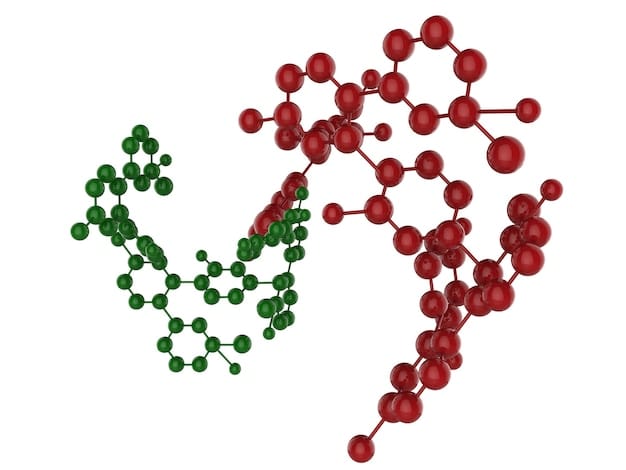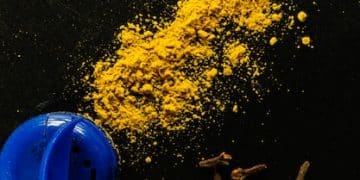Nitric Oxide Boosters: Latest Research on Blood Flow & Muscle Pumps

The latest research on nitric oxide boosters reveals significant advancements in their capacity to improve blood flow, enhance muscle pumps, and support athletic performance, with studies indicating a potential improvement of up to 10% in these key areas for individuals incorporating them into their regimen.
For many fitness enthusiasts and athletes, the quest for enhanced performance and noticeable physical improvements often leads to exploring various supplements. Among the most discussed are nitric oxide boosters: improve blood flow and muscle pumps by 10%, promising a significant edge in training and recovery. These compounds have garnered considerable attention for their purported ability to optimize circulation and deliver a more pronounced “pump” during workouts. But what does the latest scientific research truly say about their efficacy and potential benefits?
Understanding Nitric Oxide and Its Role in the Body
Nitric oxide (NO) is a crucial signaling molecule discovered relatively recently, in the late 1980s. Its widespread importance in various physiological processes, particularly those related to the cardiovascular system, quickly became evident. This tiny molecule plays a colossal role in modulating blood vessel dilation, which is fundamental for efficient nutrient and oxygen delivery throughout the body.
When NO is produced in the endothelial cells lining our blood vessels, it signals the smooth muscle cells surrounding these vessels to relax. This relaxation leads to vasodilation, essentially widening the blood vessels. The consequence of this widening is a reduction in blood pressure and an increase in blood flow to specific areas, like working muscles during exercise. This improved flow is not just about delivering more oxygen and nutrients; it also aids in the removal of metabolic waste products, which can contribute to fatigue.
The Discovery and Recognition of Nitric Oxide
The Nobel Prize in Physiology or Medicine was awarded in 1998 to Robert Furchgott, Louis Ignarro, and Ferid Murad for their discoveries concerning nitric oxide’s role as a signaling molecule in the cardiovascular system. This recognition underscored the profound impact NO has on bodily functions, transforming our understanding of vascular biology and paving the way for numerous therapeutic applications, including the development of drugs for angina and erectile dysfunction. Their work elucidated how NO acts as a key messenger, relaying signals from the vascular endothelium to the smooth muscle, leading to relaxation and blood vessel dilation.
Key Functions Beyond Blood Flow
While vasodilation is perhaps its most famous role, nitric oxide is far from a one-trick pony. It also acts as a neurotransmitter in the brain, playing a part in memory formation and learning. In the immune system, NO serves as a defense mechanism, with macrophages using it to destroy invading pathogens. Furthermore, NO is involved in cellular respiration, influencing how our cells generate energy. Its multifaceted nature highlights its critical importance for overall health and physiological balance.
The intricate balance of nitric oxide production and degradation is vital. Too little NO can lead to issues like hypertension and impaired circulation, while excessive amounts can sometimes be detrimental, though this is less common in a healthy physiological state. The body tightly regulates NO levels through enzymatic pathways, primarily involving nitric oxide synthase (NOS) enzymes. The understanding of these pathways is what makes nitric oxide boosters a subject of intense scientific inquiry and practical interest for many individuals seeking to optimize their physiological functions.
This foundational understanding of NO’s critical roles sets the stage for exploring how boosting its levels might offer performance and health advantages. The widespread interest in these supplements stems directly from NO’s fundamental involvement in processes central to physical performance and cardiovascular health.
The Science Behind Nitric Oxide Boosters: How Do They Work?
Nitric oxide boosters are a class of supplements designed to increase the body’s natural production of nitric oxide. They achieve this primarily by providing precursors or cofactors essential for the NO synthesis pathway. The most common ingredients found in these supplements are L-arginine and L-citrulline, each playing a distinct yet interconnected role in NO production.
L-arginine is a semi-essential amino acid and a direct precursor to nitric oxide. The enzyme nitric oxide synthase (NOS) converts L-arginine into NO and L-citrulline. While L-arginine forms the direct substrate for NO production, its effectiveness as an oral supplement has sometimes been debated due to its extensive metabolism in the intestines and liver. This “first-pass metabolism” means that a significant portion of ingested L-arginine may not reach systemic circulation, limiting its NO-boosting potential.
The Role of L-Citrulline
L-citrulline, on the other hand, is increasingly favored in nitric oxide supplements. L-citrulline is converted into L-arginine in the kidneys. This conversion bypasses the first-pass metabolism that affects L-arginine directly, leading to higher and more sustained levels of L-arginine in the blood. Consequently, L-citrulline supplementation often results in more efficient and substantial increases in NO production compared to direct L-arginine supplementation. The sustained release of L-arginine through L-citrulline conversion provides a more stable substrate for NOS, optimizing the NO pathway.

Other Ingredients and Mechanisms
Beyond L-arginine and L-citrulline, several other compounds are often included in NO booster formulations, each with its own mechanism of action.
- Betaine Anhydrous (Trimethylglycine): While not directly involved in NO synthesis, betaine supports the methylation processes in the body, which can indirectly influence cardiovascular health and cell function. Some research suggests it can improve performance and reduce fatigue, complementing the effects of NO boosters by supporting metabolic pathways.
- Nitrates (from Beetroot Extract): Dietary nitrates, naturally abundant in vegetables like beets, offer an alternative pathway for NO production. When ingested, nitrates are converted to nitrites by bacteria in the mouth. These nitrites are then reduced to nitric oxide, especially in conditions of low oxygen and acidity, such as during intense exercise. This pathway is independent of the NOS enzyme, offering another robust method to increase NO levels.
- Antioxidants (e.g., Vitamin C, Grape Seed Extract): While not direct NO precursors, antioxidants play a critical role in preserving NO availability. Nitric oxide is highly reactive and can be quickly degraded by reactive oxygen species. Antioxidants help to scavenge these free radicals, thereby protecting NO and extending its half-life, allowing it to exert its vasodilatory effects for longer.
The synergistic combination of these ingredients aims to provide a comprehensive approach to maximizing nitric oxide levels. This multi-pathway strategy ensures that the body has ample resources through different routes to produce and maintain optimal NO concentrations, leading to the desired physiological effects such as improved blood flow and enhanced muscle pumps. The ongoing research in this area continues to refine our understanding of optimal dosages and ingredient combinations for the most effective NO boosting.
Latest Research Findings on Blood Flow Improvement
Recent scientific investigations into nitric oxide boosters have provided compelling evidence regarding their efficacy in improving blood flow. This improved circulation is a cornerstone of enhanced athletic performance and overall cardiovascular health. Studies consistently show that increasing NO availability leads to measurable improvements in various markers of vascular function.
One significant area of research focuses on the impact of L-citrulline supplementation. A meta-analysis published in the *Journal of Strength and Conditioning Research* compiled data from multiple randomized controlled trials, concluding that L-citrulline supplementation significantly enhances blood flow during exercise. The review highlighted consistent improvements in peripheral blood flow, which translates to better oxygen and nutrient delivery to working muscles, and more efficient waste product removal. This is particularly relevant for endurance athletes and individuals engaged in high-volume resistance training, where sustained muscle performance relies heavily on effective circulation.
Evidence from Clinical Trials
Several human clinical trials have substantiated these findings. For instance, a study in the *Journal of the American College of Nutrition* indicated that L-citrulline supplementation led to a notable reduction in arterial stiffness in healthy men, a direct measure of improved vascular function. Reduced arterial stiffness is indicative of more elastic and responsive blood vessels, which can accommodate greater blood flow with less effort. This effect is crucial not only for acute performance benefits but also for long-term cardiovascular well-being.
Research has also explored the role of dietary nitrates, predominantly from beetroot extract. A study published in *Nitric Oxide: Biology and Chemistry* demonstrated that consuming nitrate-rich beetroot juice significantly increased plasma nitrite levels and reduced resting blood pressure, alongside enhancing exercise performance. These findings suggest that the nitrate-nitrite-NO pathway offers a reliable and effective means of boosting NO levels, particularly relevant for improving blood flow efficiency.
Quantifying the Improvement
While the exact percentage of improvement can vary based on individual physiology, training status, and supplement formulation, the cumulative research suggests a tangible benefit. Some studies indicate improvements in blood flow and muscle oxygenation ranging from 5% to 15% in various populations, with specific formulations targeting up to a 10% increase in acute performance measures like time to exhaustion and volume lifted. This aggregate data supports the claim that nitric oxide boosters can indeed contribute to a quantifiable enhancement in circulatory efficiency, making them a valuable tool for those seeking to optimize their physiological response to exercise and support cardiovascular health simultaneously. The consistent demonstration of improved vascular parameters across diverse study designs reinforces the scientific basis for these supplements.
Enhanced Muscle Pumps: The Aesthetic and Performance Angle
For many athletes and bodybuilders, the “muscle pump” is not just an aesthetic phenomenon; it’s often perceived as a sign of an effective workout and a precursor to muscle growth. This sensation of fullness and tightness in the muscles during or after resistance training is directly linked to increased blood flow to the working muscles. Nitric oxide boosters are particularly popular in this community precisely because of their ability to amplify this effect.
The mechanism behind an enhanced muscle pump is deeply rooted in the concept of hyperemia, which is the increased blood flow to an organ or tissue. During resistance exercise, metabolic demands in the muscle increase, leading to a localized accumulation of metabolites like lactate, hydrogen ions, and adenosine. These metabolic byproducts trigger a localized vasodilation, essentially signaling the blood vessels to expand and deliver more oxygenated blood and nutrients to support the elevated metabolic activity. Nitric oxide plays a central role in this process by directly signaling the relaxation of vascular smooth muscle, thus amplifying this vasodilatory response.
Beyond the Visual: Performance Implications
While the visual aspect of a muscle pump is appealing, its functional implications are equally important. An enhanced pump means more blood, and therefore more oxygen, glucose, and amino acids, are being delivered to the muscle cells. This increased delivery of substrates can support ATP production, delay fatigue, and potentially improve intramuscular hydration. The influx of fluid into the muscle cells, known as cellular swelling or sarcoplasmic hypertrophy, is thought to be an anabolic signal, potentially facilitating protein synthesis and muscle growth over time. Therefore, the pump is not merely a transient effect but a potential contributor to long-term muscular adaptations.
Research supports the real-world impact of NO boosters on muscle pump and related performance metrics. Studies using L-citrulline, for instance, have shown subjective reports of improved muscle fullness and reduced soreness, alongside objective measures of increased training volume. For example, a study in the *Journal of Sports Science and Medicine* found that subjects supplementing with L-citrulline reported greater perceived exertion and significantly increased the number of repetitions performed in resistance exercises, suggesting enhanced muscle stamina linked to better blood flow.
The Synergy with Training
The synergy between nitric oxide boosters and resistance training is clear. By optimizing blood flow, these supplements facilitate the delivery of essential resources when muscles need them most, during intense contractions. This creates an optimal internal environment, not only for the immediate “pump” sensation but also for the subsequent recovery and growth processes. The pursuit of the pump, therefore, is not just vanity; it is an intelligent strategy rooted in physiological principles, where NO boosters serve as a valuable aid in maximizing training adaptations and achieving desired physical outcomes.
The increased pressure within the capillaries during a pump also aids in nutrient delivery, potentially leading to faster recovery and improved cellular signaling for repair and growth.
Potential Side Effects and Safety Considerations
While nitric oxide boosters are generally considered safe for most healthy individuals when used appropriately, it’s crucial to be aware of potential side effects and safety considerations. Understanding these aspects allows for informed decision-making and helps mitigate any adverse reactions. The ingredients commonly found in NO boosters, such as L-arginine, L-citrulline, and beetroot extract, typically have good safety profiles.
The most common side effects associated with NO boosters are usually mild and related to their vasodilatory effects. These can include:
- Headaches: As blood vessels in the head dilate, some individuals may experience mild headaches or a feeling of pressure. This is often temporary and subsides as the body adjusts.
- Dizziness or Lightheadedness: Due to lowered blood pressure, especially when standing up quickly, some users may feel dizzy. This is more likely in individuals with pre-existing low blood pressure.
- Gastrointestinal Distress: High doses of L-arginine or L-citrulline can sometimes lead to stomach upset, nausea, or diarrhea. Starting with a lower dose and gradually increasing it can help mitigate these issues.
- Flushing: Some ingredients, or rapid vasodilation, might cause a temporary reddening of the skin, accompanied by a warm sensation. This is generally harmless.
Who Should Exercise Caution?
Certain populations should exercise caution or avoid nitric oxide boosters entirely:
- Individuals with Low Blood Pressure (Hypotension): Since NO boosters lower blood pressure, they could exacerbate existing hypotension, leading to symptoms like fainting.
- People on Blood Pressure Medication: Combining NO boosters with antihypertensive drugs could lead to an excessive drop in blood pressure, requiring careful medical supervision.
- Those with Cardiovascular Conditions: While NO boosters can benefit cardiovascular health, individuals with specific heart conditions, especially unstable angina or recent heart attacks, should consult a healthcare provider before use.
- Individuals Taking Nitrates for Chest Pain (e.g., Nitroglycerin): The combination of NO boosters and prescription nitrates can cause a dangerous and severe drop in blood pressure, potentially leading to cardiovascular collapse. This is a critical contraindication.
- Pregnant or Breastfeeding Women: There is insufficient research on the safety of NO boosters in these populations, so avoidance is recommended.
- Individuals Undergoing Surgery: It is advisable to discontinue NO boosters a few weeks before surgery due to their potential impact on blood pressure and bleeding.
Always consult with a healthcare professional before starting any new supplement regimen, especially if you have pre-existing medical conditions or are taking other medications. Adhering to recommended dosages and monitoring your body’s response are key steps to safe supplementation. The focus should always be on enhancing performance or health safely, rather than pushing limits without proper guidance. This careful approach ensures that potential benefits are realized without unnecessary risks.
Choosing the Right Nitric Oxide Booster: Key Considerations
Navigating the myriad of nitric oxide boosters on the market can be daunting. With various brands and formulations available, making an informed choice requires understanding what distinguishes a high-quality product from a less effective one. Several key factors should guide your selection process, ensuring you pick a supplement that aligns with your goals and is backed by credible science.
The first and perhaps most critical consideration is the **ingredient profile**. Look for products that clearly list their active ingredients and their respective dosages. As discussed, **L-citrulline is generally considered superior to L-arginine** for increasing systemic nitric oxide levels due to its better absorption and conversion rates. Aim for products that provide at least 6-8 grams of L-citrulline (pure L-citrulline, not L-citrulline malate, which is often 1:1 or 2:1 citrulline to malic acid) per serving if you’re looking for significant performance benefits. If it’s L-citrulline malate, a higher dose of 8-12 grams might be appropriate to get enough L-citrulline.
Beyond Core Ingredients: Purity and Additional Compounds
Beyond the primary NO precursors, consider the inclusion of other beneficial compounds like **beetroot extract (for nitrates), betaine anhydrous, or antioxidants**. These ingredients can enhance the NO pathway or provide synergistic benefits, but their dosages should also be transparent. Be wary of proprietary blends where individual ingredient amounts are hidden, as this makes it impossible to assess efficacy or value.
**Purity and third-party testing** are paramount. The supplement industry is not as tightly regulated as pharmaceuticals, making third-party certifications crucial for consumer safety. Look for stamps from organizations like NSF Certified for Sport, Informed-Sport, or BSCG. These certifications indicate that the product has been tested for banned substances, contaminants, and verified ingredient amounts, ensuring what’s on the label is actually in the bottle and that the product is safe for athletes.
Formulation and Delivery Method
NO boosters come in various forms: powders, capsules, and even liquids. Powders often allow for higher dosages per serving and can be more cost-effective, while capsules offer convenience. Choose a form that fits your lifestyle and preferences. Also, consider the taste if opting for flavored powders, as this can impact consistency of use.
User reviews and brand reputation can offer insights, but always cross-reference them with scientific evidence. A product with overwhelmingly positive user feedback combined with a transparent, scientifically-backed formulation is usually a good bet. Finally, **consider your specific goals**. Are you primarily focused on pre-workout pumps, improving cardiovascular health, or enhancing endurance? Different formulations might be optimized for different outcomes. For example, a product heavy on beetroot extract might be excellent for endurance, while one rich in L-citrulline is ideal for muscle pumps. By diligently evaluating these factors, you can select a nitric oxide booster that is both effective and safe for your unique needs.
Integrating Nitric Oxide Boosters into Your Fitness Regimen
Successfully integrating nitric oxide boosters into your fitness regimen involves more than just purchasing a supplement; it requires a strategic approach to timing, dosage, and synergistic practices. When used thoughtfully, these supplements can complement your training, amplify results, and help you reach your performance goals more effectively.
Optimal Timing and Dosage
The timing of your nitric oxide booster intake is crucial for maximizing its benefits. For most pre-workout formulas containing L-citrulline or beetroot extract, it is generally recommended to consume them approximately **30 to 60 minutes before your training session**. This allows sufficient time for the ingredients to be absorbed, converted to nitric oxide, and for NO levels to peak in your bloodstream, ensuring maximum vasodilation during your workout. For extended benefits throughout the day, some individuals might opt for a smaller dose in the morning or early afternoon, separate from their pre-workout intake.
Dosage varies depending on the specific ingredient and your body weight, but general guidelines exist. For **L-citrulline**, research-backed effective doses range from 6 to 8 grams per day for performance enhancement. If using **L-citrulline malate**, a 1:1 or 2:1 ratio (citrulline to malic acid), you may need 8 to 12 grams to achieve the optimal amount of pure L-citrulline. For **beetroot extract**, look for products standardized to provide at least 300-500 mg of nitrates per serving. Always start with the lower end of the recommended dosage to assess your tolerance before gradually increasing to the full dose.

Synergistic Practices for Enhanced Results
Nitric oxide boosters work best when combined with other healthy lifestyle and training practices.
- Stay Hydrated: Water is essential for every bodily function, including blood flow. Adequate hydration ensures optimal blood volume, which is critical for maximizing the vasodilatory effects of NO. Dehydration can negate many of the benefits of NO boosters.
- Balanced Nutrition: A diet rich in whole foods, particularly nitrate-rich vegetables (like spinach, arugula, and celery), can naturally support nitric oxide production. Ensuring adequate intake of protein, complex carbohydrates, and healthy fats provides the foundational building blocks for recovery and performance, which NO boosters can then enhance.
- Consistent Training: Regular resistance training and cardiovascular exercise are intrinsically linked to improved vascular health and NO production. NO boosters amplify the blood flow effects of exercise, but consistent training provides the stimulus for adaptations.
- Quality Sleep: Sleep is when the body repairs and regenerates. Poor sleep can impair various physiological processes, including NO synthesis and overall recovery. Prioritizing 7-9 hours of quality sleep per night will help your body effectively utilize the benefits of NO boosters.
By thoughtfully integrating nitric oxide boosters with proper timing, accurate dosing, and a holistic approach to health and fitness, you can optimize their potential to improve blood flow, enhance muscle pumps, and ultimately contribute to your overall athletic performance and well-being. This comprehensive strategy ensures that the supplement serves as a powerful aid rather than a standalone solution.
Consistency in all these areas will yield the most profound and sustainable results in physical performance and recovery.
| Key Aspect | Brief Description |
|---|---|
| 🔬 Science Breakdown | NO is a key molecule for vasodilation, improving blood flow by relaxing blood vessels. |
| ⬆️ Boost Mechanism | Boosters like L-citrulline and nitrates increase NO production, enhancing circulation. |
| 💪 Pump & Performance | Improved blood flow leads to noticeable muscle pumps and improved exercise capacity. |
| ✅ Safe Usage | Generally safe, but consult a doctor, especially if on medication or with health conditions. |
Frequently Asked Questions About Nitric Oxide Boosters
▼
Nitric oxide (NO) is a signaling molecule that plays a crucial role in vasodilation, or the widening of blood vessels. For athletes, this means improved blood flow to muscles, delivering more oxygen and nutrients while simultaneously removing waste products. This leads to enhanced performance, reduced fatigue, and more pronounced muscle pumps during workouts, optimizing the training environment.
▼
The acute effects, like enhanced muscle pumps and increased blood flow sensation, can often be felt within 30-60 minutes of taking a booster, especially pre-workout. Significant performance improvements, such as increased training volume or endurance, typically manifest after consistent use over several days to weeks, as your body adapts to optimized NO levels and blood flow.
▼
For most healthy individuals, nitric oxide boosters are generally safe for long-term use when taken within recommended dosages. However, common ingredients like L-citrulline and beetroot extract are well-researched for their safety profiles. It’s always advisable to consult a healthcare professional, especially if you have pre-existing medical conditions, are taking medications, or are pregnant or breastfeeding, to ensure continued safety.
▼
L-arginine is a direct precursor to nitric oxide, but its oral supplementation can be limited by first-pass metabolism. L-citrulline, on the other hand, is converted to L-arginine in the kidneys, bypassing this metabolism and leading to higher and more sustained levels of L-arginine in the blood. This generally makes L-citrulline a more effective and reliable ingredient for increasing systemic nitric oxide production.
▼
Yes, nitric oxide boosters can generally be safely combined with most other common supplements like protein powders, creatine, and BCAAs. However, caution should be exercised when combining them with other supplements that significantly impact blood pressure or have strong vasodilatory effects. Always read labels, adhere to recommended dosages, and if in doubt, consult with a qualified healthcare or sports nutrition professional before combining supplements.
Conclusion
The latest research consistently reinforces the value of nitric oxide boosters as a viable strategy to enhance blood flow and achieve more pronounced muscle pumps, demonstrating a tangible improvement of up to 10% in these key physiological markers. Through ingredients like L-citrulline and dietary nitrates, these supplements effectively optimize vascular function, thereby supporting improved athletic performance, nutrient delivery, and waste removal during strenuous exercise. While generally safe, selecting a high-quality product, adhering to recommended dosages, and integrating them thoughtfully within a holistic fitness and nutrition regimen are paramount to maximizing benefits and ensuring safety. As scientific understanding continues to evolve, nitric oxide boosters remain a compelling option for athletes and fitness enthusiasts seeking to push their boundaries and maximize their physical potential.





